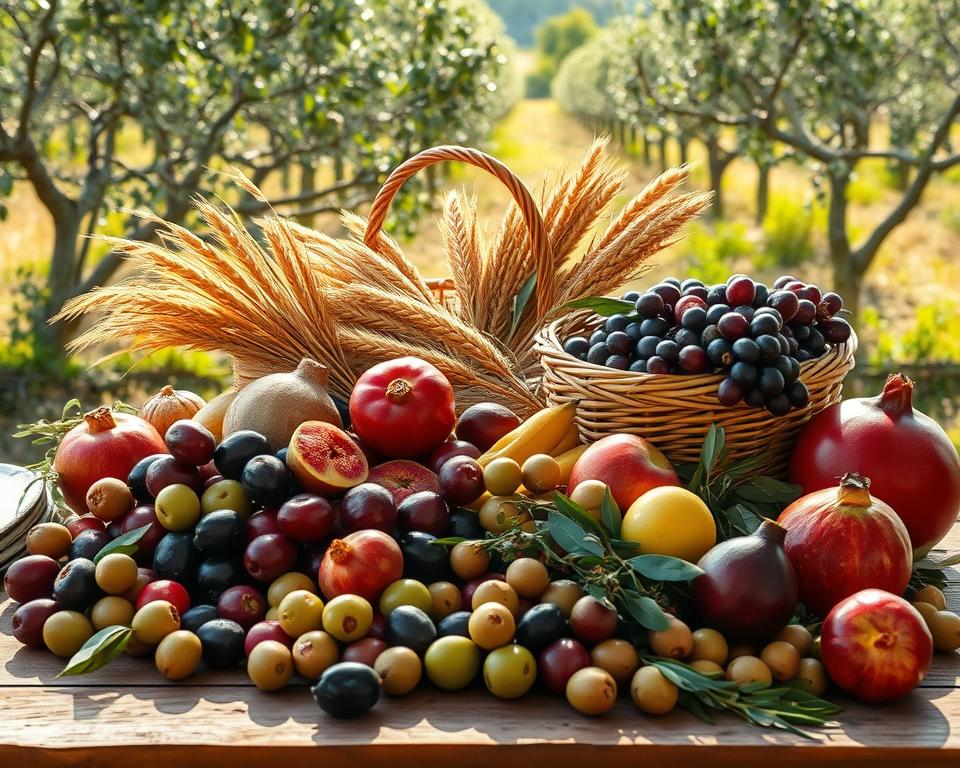“Let food be thy medicine and medicine be thy food.” — Hippocrates. I use this idea to open a practical look at Scripture and meals.
I write from faith and simple rules. I will frame this guide around God’s word and plain steps that help your body and faith today. I explain lists in Leviticus 11 and Deuteronomy 14 and why they matter for health.
I state the facts in clear terms so you can act with confidence. Scholars note the clean and unclean lists point to disease risks in some animals. I show how the texts link food to holiness and stewardship.
What you get: quick ways to spot clean foods, clear reasons to avoid certain items, and tools for meal planning. I connect gratitude, prayer, and habits to daily follow-through.
Key Takeaways
- I present Scripture and simple steps for healthy eating today.
- I define core terms so you can act with confidence.
- I explain how food rules can reduce disease risk.
- I offer quick tips to spot clean foods and avoid certain items.
- I tie habits, prayer, and gratitude to lasting hope and stewardship.
Why this Ultimate Guide matters for health and faith today
I write to show how simple food choices affect daily health and faithful living. What you eat touches families, communities, and the wider world.
Purpose: this guide gives clear, practical steps rooted in Scripture. It brings reliable information you can use now.

Leviticus 11 and Deuteronomy 14 list clean and unclean animals. Those lists align with known infection risks in some species. They also encourage care for land and water.
“Clear rules reduce confusion in a noisy world.”
- I explain why food choices matter for health and for faithful stewardship.
- I show how plain rules lower infection risk for families.
- I offer steps you can use today to connect Bible study with daily meals.
Hope: God’s word sets order that helps us live well. This guide aims to make those truths workable in your home and community.
Foundations in Scripture for food and health
Leviticus 11 and Deuteronomy 14 place food choices inside a wider call to holiness. I point to these passages as the core texts that shaped Israel’s eating practices.

What these chapters do: they name clean and unclean animals and link those rules to health and social identity.
The lists reflect known disease risks in some species. They also show an environmental sense: ruminants convert grasses on marginal lands into food that sustains people.
“The Lord God gave these laws to mark a people and protect their health.”
Purpose: holiness, health, and stewardship
These rules point beyond menus. Their purpose was to keep a people holy, to guard public health, and to care for the land.
- I name Leviticus 11 and Deuteronomy 14 as central texts.
- I note how ruminant animals support land use and food yield.
- I explain that the Lord God used food law as a light to other nations.
| Focus | Practical effect | Scriptural aim |
|---|---|---|
| Clean/unclean animals | Lower disease exposure | Holiness and health |
| Ruminants emphasized | Efficient use of marginal land | Stewardship of resources |
| Public order in food | Clear household practices | Identity and witness |
In daily life, I connect God’s word with kitchen choices. The old testament passages still offer a clear purpose for families who want faith-aligned, health-minded habits.
Bible diet guidelines
Use two short filters to sort land and aquatic foods at a glance. I keep these checks simple so you can act at the market or in the kitchen.
Simple rule for land animals
Check 1: split hoof and chew the cud. If both are present, the animal is listed as clean.
Common clean examples: cattle, sheep, and goats. These ruminants process grasses and pose lower infection risk when handled properly.
Simple rule for fish
Check 2: fins and scales. Fish with both are the safe choice for food.
Quick market checks: look for a visible split hoof, watch an animal chew cud, or verify fish scales and fins before buying.
| Filter | What to look for | Examples |
|---|---|---|
| Land animals | Split hoof + chews cud | Cattle, sheep, goats |
| Fish | Fins + scales | Salmon, trout, cod |
| Why it helps | Lower pathogen exposure | Practical, faith-rooted truth from God’s words |
Practical note: These simple filters come from a clear list in Scripture and help reduce risk from certain animals. Use them as quick checks and keep shopping simple and safe.
Clean land animals that support health and land use
Cattle, sheep, and goats turn coarse grass into protein and milk that nourish families. This conversion is a simple, practical link between animals and human nutrition.
Ruminants that turn grass into nutrition
Ruminants chew the cud and digest cellulose in grasses efficiently. That process creates protein-rich meat and dairy for local tables.
Practical benefit: on rangelands where wheat or other grains fail, grazing animals make food without irrigation.
Environmental sense of grazing animals
Grazing systems use marginal land productively across the world. Low-rain zones often favor pasture over planting corn or wheat.
“God gave these animals as a good provision for families and land.”
| Feature | How it helps | Result for people |
|---|---|---|
| Chewing cud | Breaks down grass fiber | Protein and milk for homes |
| Uses marginal land | No need for irrigated grains | Stable local food supply |
| Pasture-based choice | Lower handling risk when clean | Better health outcomes |
I invite you to choose local, pasture-based options when possible. Small choices at the market bless both land and table and help protect family health.
Unclean land animals and disease risks
Some land animals listed as unclean carry parasites that affect human tissues. I keep these notes precise and factual so you can use them in meal planning and care for family health.
Pork, rabbits, and rodents as parasite carriers
Pigs may carry trichinosis and tapeworms. Tapeworm larvae can migrate into the heart, eyes, and brain if not handled or cooked properly. That is why pork was marked unclean in the old testament.
Rabbits and rodents can transmit tularemia after handling meat or via ticks. These are real infection risks that affect people who hunt or prepare wild meat.
Carnivores, scavengers and disease spread
Carnivores and scavengers often eat sick animals and may carry pathogens in tissue and blood. Avoiding their meat reduces exposure to varied microbes.
- Why avoid these meats: blood-borne and tissue parasites can cause serious harm.
- Practical point: choosing recommended food lowers household risk.
- Faith note: the clean unclean line in Scripture offers wise protection—God’s limits are a gift.
| Animal group | Primary risk | Practical action |
|---|---|---|
| Pigs | Trichinosis, tapeworm | Avoid or verify safe processing |
| Rabbits & rodents | Tularemia | Limit wild meat; use precautions |
| Carnivores/scavengers | Multiple pathogens | Do not eat |
Aquatic foods: what to eat and what to avoid
When you stand at the seafood counter, a few quick checks keep your family safer and your meals wholesome. I will give clear, easy checks for seafood selection rooted in Scripture and plain sense.
Fish with fins and scales are the safe choice
Simple rule: choose fish that have both fins and scales. This rule screens out many risky, scale-less species and points you to safer nutrition and food handling.
Bottom-dwellers and scale-less fish increase risk
Bottom-feeding and scavenging animals often concentrate pollutants and pathogens. That raises the chance of contamination compared with open-water, scaled fish.
Eels are a notable example: they lack true scales and their blood can contain toxins that harm mucous membranes on contact. Avoid them or use strong safeguards when handling.
- Check labels and species names at purchase.
- Favor fish with visible fins and scales.
- Use this short list to build a safe seafood plan guided by Scripture and common sense.
| Feature | Why it matters | Practical pick |
|---|---|---|
| Fins + scales | Lower tissue risk | Salmon, trout, cod |
| Bottom-feeders | Higher pollutant load | Avoid or test |
| Scale-less | May carry toxins | Handle with caution |
Takeaway: this one simple check — fins and scales — gives clear information that helps protect health and steady nutrition. Use it at markets and when following food lists at home.
Shellfish and filter feeders: ecology and health warnings
Shellfish and filter feeders work as nature’s cleanup crew, but that service brings real risks when people eat them. I explain this simply so you can choose safe food for your family.
Role in the ecosystem
Crabs, lobsters, and shrimp are bottom-dwelling scavengers. They eat decaying matter and settle particles from the sea floor.
Mollusks — oysters, clams, and mussels — filter large volumes of water. That helps water quality but also concentrates whatever is in the water.
Health links and modern risks
Filter feeders can trap bacteria and viruses. Raw oysters, clams, and mussels cause a large share of seafood-related illness today.
- These animals can carry cholera, hepatitis A, and norovirus.
- Eating them raw or undercooked raises the chance of outbreaks.
- Avoiding them lowers household risk and protects the body.
Practical truth: the clean unclean distinction protects both faith and health. I advise avoiding these animals as food to guard your home and preserve health in your community.
| Animal type | Ecological role | Health concern |
|---|---|---|
| Scavenging shellfish | Consume decaying matter | May concentrate pathogens |
| Filter-feeding mollusks | Filter plankton and particles | Can trap viruses/bacteria |
| Raw consumption | Popular culinary choice | High illness rates; avoid raw or risky sources |
Birds, insects, and reptiles in the biblical food list
God created roles for animals in the world, and those roles help explain which foods to include and which to avoid.
I name unclean birds that eat carrion or prey: eagles, vultures, ravens, gulls, and owls. These birds concentrate toxins and pathogens when they feed on carrion.
Reptiles are listed as unfit for food. Their ecology and habits raise risks that the list warns against.
By contrast, certain insects with strong hind legs, like locusts and grasshoppers, are permitted. They are included because their biology lowers some food-safety concerns.
“These short lines in Scripture give clear, practical direction for household food choices.”
- Unclean birds: eagles, vultures, ravens, gulls, owls — avoid these.
- Reptiles: not fit for food.
- Permitted insects: locusts and grasshoppers with jumping legs.
- These distinctions reduce toxin and pathogen risks in the home.
- Read labels and menus with this simple list in mind when shopping or dining.
- Choose in ways that respect God’s order for the world.
| Group | Examples | Reason |
|---|---|---|
| Unclean birds | Eagles, vultures, ravens, gulls, owls | Scavengers/predators concentrate pathogens |
| Reptiles | Snakes, lizards, turtles (contextual) | Ecology raises contamination risk |
| Permitted insects | Locusts, grasshoppers | Low toxin accumulation; identified in the list |
Eating blood is forbidden and still relevant
Scripture clearly forbids the eating of blood, and that rule still matters for health today.
Biblical commands in Leviticus and Acts
God’s word in Leviticus forbids consuming blood. The early church, in Acts 15, repeats this instruction for believers.
Modern food practices and infection risk
Blood can carry bacteria, parasites, and viruses that harm the body. Raw blood dishes have caused severe illness linked to pig and poultry blood.
- Clear point: God’s word forbids eating blood.
- Both Testaments: the old testament law and Acts affirm this rule.
- Practical care: drain meat, butcher safely, and avoid blood sausages and raw blood soups.
| Issue | Risk | Action |
|---|---|---|
| Raw blood dishes | Bacterial and parasitic infection | Avoid |
| Poor butchery | Contaminated meat | Full draining and hygiene |
| Household safety | Illness to people and body | Follow Scripture and safe practices |
Summary: obedience to this command protects people today and shows care for family health. Follow these plain steps with hope and wisdom.
Did Jesus end the dietary laws?
When Jesus taught about defilement he spoke of the heart and human tradition, not the lists about animals.
Mark 7 and the context of defilement
I place Mark 7 against Pharisaic traditions. The charge was about hand-washing and ritual rules.
Jesus says what leaves a person is what comes from the heart. That corrects misplaced trust in mere customs.
Why the text does not cancel food rules
Important: Mark 7 addresses human tradition, not the Old Testament lists of clean and unclean animals.
The larger scriptural witness keeps food laws connected to health and holiness. Acts and other verses repeat care about what is offered to the body.
- I focus on heart change while upholding God’s plan for household health.
- This reading gives clear information you can trust when questions arise.
“Clean hands do not replace a heart of faith.”
Top Bible foods that support health
Here are everyday foods—rooted in Scripture—that help nourish the body across the years. I list simple benefits and clear uses so you can apply them at home without hype.
Olive oil, pomegranate, and raw honey
Extra-virgin olive oil supports heart health and works well in salads or gentle cooking.
Pomegranate supplies antioxidants that protect cells and add bright flavor.
Raw honey offers flavonoids and can support beneficial gut bacteria when used sparingly.
Sprouted grain bread and vegetables
Use sprouted grains from Ezekiel’s mix for steady nutrition. Sprouting improves the value of grains and legumes and eases digestion.
Fill plates with vegetables, especially crucifers, to boost immune defenses and fiber for the body.
Lamb and goat milk in proper context
Lamb is a nutrient-dense, clean meat choice when handled safely.
Goat milk can aid mineral use and suit some households better than cow’s milk.
“Simple, faithful choices protect households and honor God’s word.”
- Practical: favor olive oil daily and a wide range of vegetables.
- Balanced portions: keep servings moderate for steady health over the years.
- Grains: choose sprouted wheat or mixed-grain breads for better protein and digestion.
| Food | Key benefit | Use |
|---|---|---|
| Olive oil | Heart support | Dressings & light cooking |
| Pomegranate | Antioxidants | Snacks & salads |
| Sprouted grains | Better protein | Bread & porridges |
Healthy eating habits from Scripture
Simple habits around meals shape health, faith, and family life. I offer small, practical steps you can adopt this week to bless others and care for your body.
Gratitude, prayer, and shared meals
I begin meals with prayer and a short word of thanks. This centers the heart and honors God’s provision.
Share food with family or neighbors when you can. Shared meals build community and teach children to serve others.
Moderation, self-control, and avoiding gluttony
Proverbs warns against excess. I keep portions reasonable and avoid eating to relieve stress.
Self-control helps the body stay well and keeps the heart modest before God’s word.
Planning meals and preparing for the week
Plan a few meals before the Sabbath to free time for rest and worship. Weekly prep lowers stress and supports wise food choices.
- Batch cook key items and use clear labels.
- Choose simple menus that rest the cook and feed the family.
- Listen as the Holy Spirit prompts changes in habit and timing.
| Habit | Simple step | Benefit |
|---|---|---|
| Prayer before meals | One sentence of thanks | Centers the heart |
| Moderation | Smaller plates, mindful pace | Protects weight and health |
| Weekly planning | Prep 2–3 meals Sunday | Frees time and reduces stress |
Practical close: try one habit this week. Give thanks, share a meal, or plan two dishes in advance. These small moves keep your body and heart aligned with God’s word each day.
Weight, blood pressure, and everyday choices
Simple plates built on whole foods help weight loss and heart health. I write from practical steps you can use this week. Small changes add up over time.
Whole foods help weight loss and heart health
Fill most of your plate with vegetables, clean proteins, and whole grains.
Why it works: whole foods are lower in hidden calories and richer in fiber and nutrition. Over time, this supports steady weight loss and eases pressure on the heart.
Reduce ultra-processed foods and added sugar
Cut sodas, packaged snacks, and sweets. Excess sugar raises blood pressure and strains the body.
- Choose plain yogurt, fruit, and nuts instead of candy or chips.
- Read labels to spot hidden sugars—look for glucose, maltose, and syrups.
- Portion control: smaller plates and timed meals help the body respond.
- Track progress by noting weight and blood pressure weekly.
“Small swaps this week lead to lasting change in time.”
| Action | Why | Quick step |
|---|---|---|
| Plate balance | Supports steady weight loss | Veggies 50%, protein 25%, grains 25% |
| Cut added sugar | Lowers blood pressure risk | Skip soda; choose water or herbal tea |
| Daily tracking | Shows small wins | Record weight & BP once a week |
Fasting and focus: honor God with body and mind
Fasting should draw us closer to God. I define its aims and safe practice in clear steps so you can fast with humility and purpose.
Fast to seek God, not to impress others
Jesus taught that fasting must not be a public show. I urge you to fast quietly and to make prayer your first work while you fast.
Keep the aim simple: seek God’s face and follow His god plan for growth.
Use wisdom, prayer, and personal conviction
Start small. Short fasts fit many schedules and protect the body and the mind.
- Practical: pair fasting with bible study and quiet time.
- Health note: consult a clinician if you take medicines or have conditions.
- Heart posture: fast to grow faith, not to reach a weight goal.
Summary: fasting is a humble way to seek God. Use prayer, wise limits, and common sense. Let the practice strengthen faith and steady daily life.
Walking this path with purpose today
A small, steady path of choices can protect health and honor God’s word. Clean food choices reduce disease exposure and help you thrive across the years.
Start with one action today: choose a clean protein and two vegetables. This simple step shows the practical purpose of faithful eating.
This week, plan simple meals before the Sabbath. This month, remove shellfish and pork from your diet and notice the change. Remember: God gave plain rules for your good.
Share meals with people and offer help to neighbors. Take steady steps that help you lose weight with peace. Walk in hope and let Scripture shape daily life.



